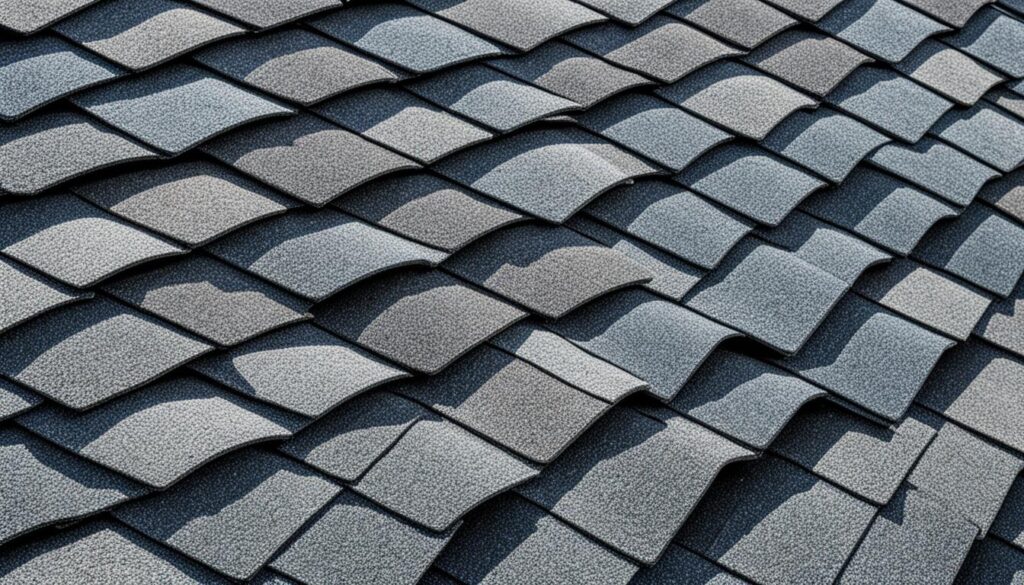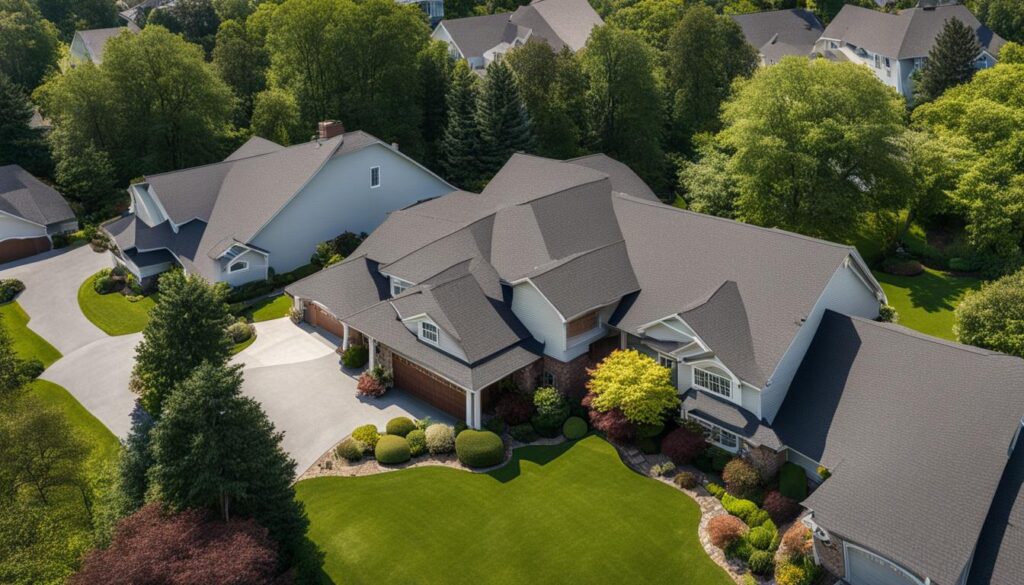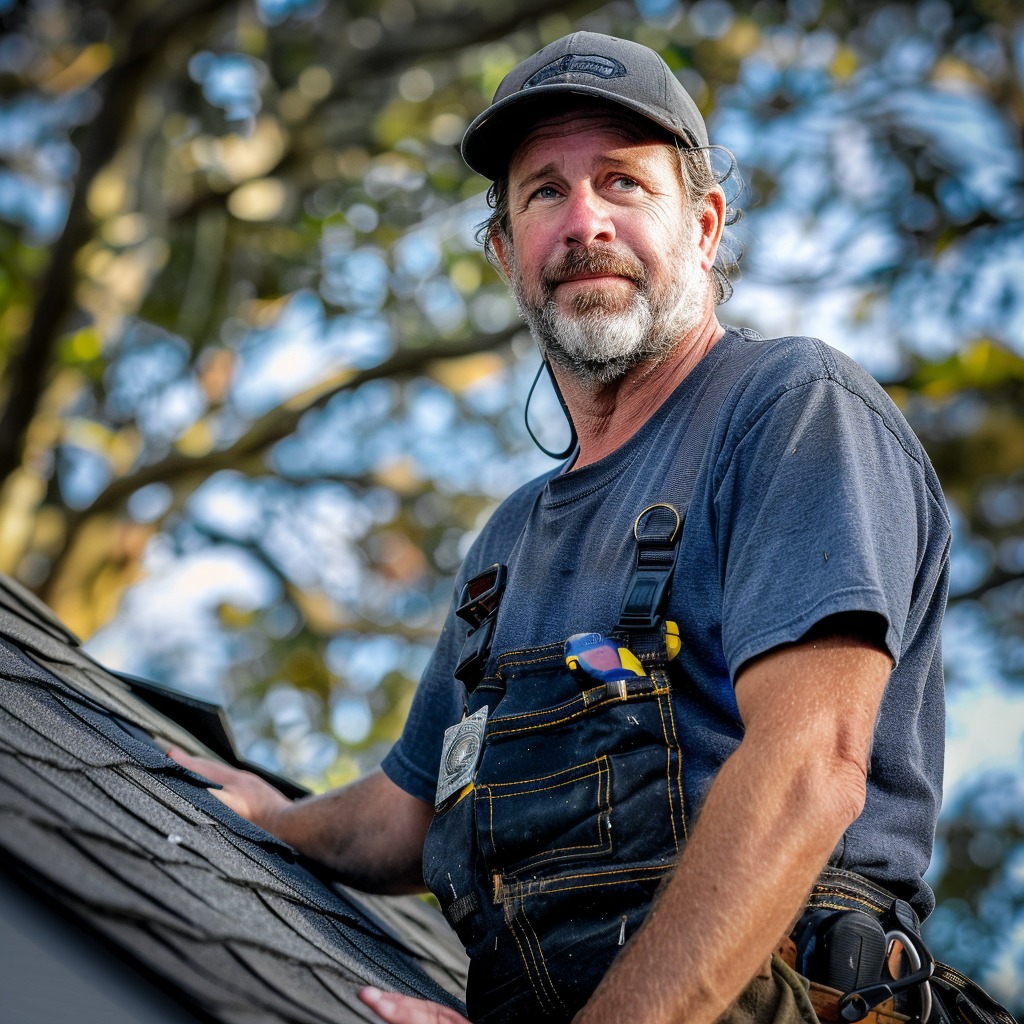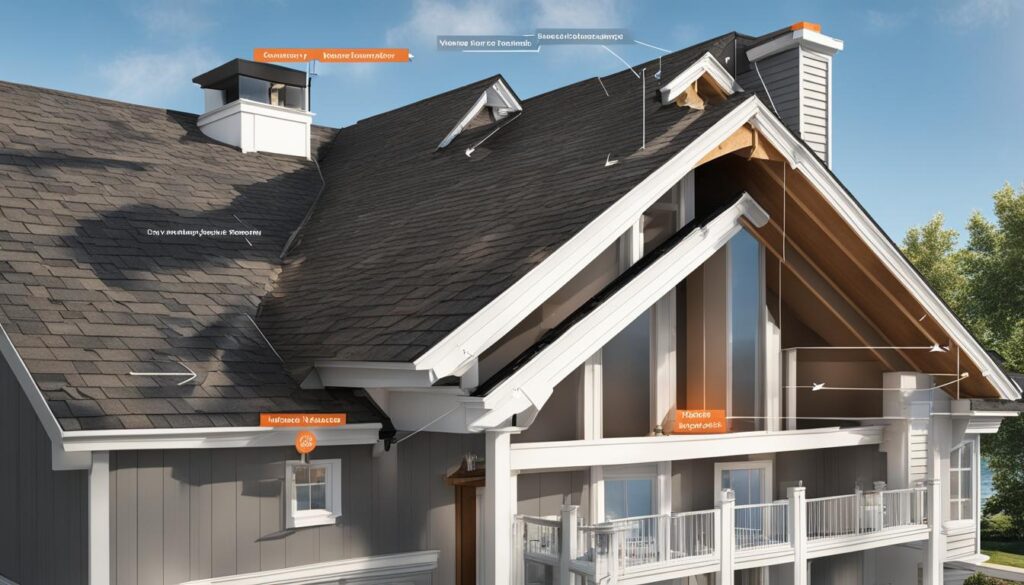Are you considering getting a new roof for your home? If so, it’s crucial to familiarize yourself with the various roofing terms you’ll come across. Knowing these terms will not only help you navigate the complexities of your roofing project but also enable you to communicate effectively with contractors and make informed decisions about your roof.
Key Takeaways:
- Understanding roofing terms is essential for effective communication with contractors.
- Familiarizing yourself with roofing terminology helps you make informed decisions about your roof.
- Knowing the right roofing terms can save you from confusion during your roofing project.
- Being knowledgeable about roofing terms enables you to accurately compare roofing quotes.
- By understanding roofing terms, you can ensure the success and longevity of your roof.
Important Roofing Terms to Know
When it comes to roofing projects, understanding key terms related to roofing materials, roofing installation, and roofing contractors is essential. This knowledge will empower you to make informed decisions and ensure the success of your project. Below, we’ll explore some important roofing terms that you should know:
Roofing Materials
Roofing materials play a crucial role in determining the durability, aesthetics, and performance of your roof. Familiarize yourself with different types of roofing materials, such as asphalt shingles, metal roofing, and clay tiles, to understand their unique properties and benefits.
Roofing Installation
The installation process is a critical aspect of any roofing project. Understanding how roofing materials are installed, including techniques like nail placement and waterproofing methods, will help you evaluate the quality of work performed by roofing contractors.
Roofing Contractor
Choosing a reputable roofing contractor is vital for the success of your project. A professional roofing contractor will have the expertise, experience, and necessary licenses and certifications to ensure a high-quality installation. They will also provide warranties and reliable post-installation support.
“The right roofing materials, proper installation, and a reliable roofing contractor are the foundation for a long-lasting and durable roof.”
Now that we’ve covered the important roofing terms related to materials, installation, and contractors, you can approach your roofing project with confidence and make well-informed decisions. When in doubt, always consult with professionals who can guide you through the process.
| Roofing Material | Description |
|---|---|
| Asphalt Shingles | One of the most common roofing materials due to its affordability, durability, and versatility. |
| Metal Roofing | Provides excellent durability, energy efficiency, and a long lifespan, making it a popular choice for homeowners. |
| Clay Tiles | Known for their distinctive aesthetic appeal and excellent durability, clay tiles are commonly seen in Mediterranean-style homes. |
Components of a Roofing System
A roofing system consists of various components that work together to ensure the functionality and longevity of your roof. Understanding these components is essential for making informed choices during your roofing project. Let’s take a closer look at some of the key elements of a roofing system:
1. Roofing Shingles

One of the most important components of a roofing system is the roofing shingles. These are the outer layer of your roof and serve as a protective barrier against the elements. Roofing shingles come in various materials, such as asphalt, metal, and clay, each with its own unique advantages.
2. Gutters
Gutters play a crucial role in preventing water damage to your roof and the foundation of your home. They collect rainwater and direct it away from your roof and the structure of your house. Proper gutter installation and maintenance are essential for the efficient functioning of your roofing system.
3. Vents
Ventilation is vital for a healthy roofing system. Vents allow air to circulate in the attic, preventing moisture buildup and reducing the risk of mold and rot. Proper ventilation also helps regulate the temperature in your home, improving energy efficiency and reducing utility costs.
4. Flashing
Flashing is used to seal joints and prevent water from entering vulnerable areas of your roof, such as around chimneys, vents, and skylights. It is typically made of metal and provides an extra layer of protection against water infiltration.
5. Soffits
Soffits are the underside of the eaves, providing ventilation for the attic and preventing moisture buildup. They also enhance the aesthetics of your roof by covering the rafter beams and other structural elements.
6. Underlayment
The underlayment is a layer of material installed between the roofing shingles and the roof deck. It acts as an additional barrier against water intrusion and helps protect the roof deck from damage. Underlayment materials include asphalt-saturated felt and synthetic materials.
| Component | Function |
|---|---|
| Roofing Shingles | Protective barrier against the elements |
| Gutters | Collect and redirect rainwater away from the roof |
| Vents | Ensure proper attic ventilation and temperature regulation |
| Flashing | Seal joints and prevent water infiltration |
| Soffits | Provide ventilation for the attic and enhance aesthetic appeal |
| Underlayment | Additional barrier against water intrusion and protection for the roof deck |
By understanding the purpose and function of each component, you can make well-informed decisions when it comes to your roofing project. Whether you’re considering a roof repair or a complete roof replacement, a comprehensive understanding of the components of a roofing system is crucial for a successful and long-lasting roof.
Common Roofing Features and Terminology
When it comes to your roof, understanding common roofing features and terminology is essential. Being familiar with terms like rafter tails, ridges, and valleys can help you better assess the maintenance and repair needs of your roof. Additionally, regular roof inspections are crucial for identifying any potential issues and ensuring the longevity of your roof.
Roofing Features
Let’s take a closer look at some common roofing features:
- Rafter Tails: Rafter tails are the visible ends of the roof rafters that extend beyond the exterior wall. They add visual appeal to your roof and protect the walls from water damage.
- Ridges: Ridges are the highest points of the roof where two roof planes meet. They provide structural support and help to prevent water infiltration.
- Valleys: Valleys are the inverted “V” shaped areas where two sloping roof planes intersect. They guide water down the roof and prevent leaks.
Roof Maintenance and Repair
Understanding these roofing features is important for maintaining and repairing your roof. Regular roof maintenance, including inspections and necessary repairs, can help prevent costly damage and extend the lifespan of your roof. It’s recommended to have a professional roofer inspect your roof annually and after severe weather events.
“Regular roof inspections are crucial for identifying any potential issues and ensuring the longevity of your roof.”
During a roof inspection, a professional will assess the overall condition of your roof, including the integrity of the roofing materials, flashing, and other components. They will look for signs of damage, such as cracked or missing shingles, damaged flashing, or leaks. Early detection of problems can prevent further damage and the need for extensive repairs.
When it comes to roof repair, it’s essential to address issues promptly. Ignoring small problems can lead to more significant damage and expensive repairs down the line. Whether it’s fixing a leak, replacing damaged shingles, or repairing flashing, hiring a professional roofing contractor is recommended to ensure the repairs are done correctly and effectively.

Regular roof maintenance and prompt repairs are key to preserving the integrity of your roof and protecting your home. By staying vigilant and addressing issues as they arise, you can avoid costly repairs and ensure the long-lasting performance of your roof.
Roof Design and Styles
Different roof designs and styles can greatly enhance the aesthetic appeal and functionality of your home. Whether you’re building a new house or considering a roof renovation project, understanding the characteristics of various designs will help you make an informed choice that suits your preferences and local climate.
Hip Roof
The hip roof design is characterized by its gentle slopes on all sides, meeting at a central ridge. This design offers excellent durability and stability, making it ideal for areas with high winds or heavy snowfall. Hip roofs also provide extra attic space and allow for efficient ventilation, improving energy efficiency and reducing utility costs.
Mansard Roof
The mansard roof, named after the French architect François Mansart, features a steep slope on all sides with a flat or low-pitched top. This design maximizes usable living space, allowing for additional rooms or storage in the attic. Mansard roofs are popular for their elegant and distinctive appearance, often associated with historic buildings and architectural charm.
Shed Roof
The shed roof, also known as a skillion roof, has a single slope, usually with a steeper pitch. This design is simple yet modern, making it a popular choice for contemporary homes and structures. Shed roofs are efficient in shedding snow and rain, making them suitable for areas with a moderate climate. They are also versatile, allowing for creative exterior and interior design possibilities.
If you’re unsure which roof design is best for your home, consult with a professional roofing contractor. They can provide expert guidance based on your specific needs, budget, and the architectural style of your property.
By selecting the right roof design for your home, you can enhance its visual appeal, improve energy efficiency, and ensure long-lasting protection against the elements.
Roofing Measurements and Units
When it comes to roof measurements, two important terms to understand are pitch and roofing squares. These measurements are essential for estimating costs and planning your roofing project effectively.
Understanding Pitch
Pitch refers to the incline or slope of your roof. It is typically expressed as a ratio or a fraction, indicating the vertical rise in relation to the horizontal run. A roof with a high pitch will have a steep slope, while a roof with a low pitch will have a more gradual slope. Understanding the pitch of your roof is crucial when determining the type of roofing materials and installation techniques that are suitable for your project.
Determining Roofing Squares
In the roofing industry, a “roofing square” is a standard unit of measurement used to calculate the amount of roofing material needed for a project. One roofing square is equal to 100 square feet of roof area. To determine the number of squares required, you need to measure the total area of your roof in square feet and then divide it by 100. This calculation will help you estimate the quantity of shingles or other roofing materials needed for your project.
“Understanding the pitch and roofing squares of your roof is essential for accurate pricing and material planning.” – [Roofing Expert]
In summary, being familiar with the pitch of your roof and understanding how roofing squares are calculated will empower you to estimate costs and plan your roofing project effectively. By working with these measurements, you can ensure that you have the necessary materials and resources to complete your roofing project successfully.
Roofing Warranty and Material Protection
When investing in a new roof, it’s essential to understand the different warranties offered by manufacturers. Two common types of warranties are prorated and non prorated warranties. Knowing the difference between these warranties can help you make an informed decision when selecting roofing materials.
A prorated warranty means that the coverage decreases over time, usually based on a specific formula. This type of warranty may offer a lower upfront cost for the materials but could result in higher expenses if repairs or replacements are needed later on. On the other hand, a non prorated warranty provides consistent coverage throughout the warranty period, ensuring peace of mind and potentially saving you money on future repairs.
Another crucial aspect of a roofing system is the underlayment. Underlayment is a barrier layer installed between the roofing material and the roof decking. It acts as an additional layer of protection against water infiltration, moisture, and extreme weather conditions. Choosing the right underlayment is vital as it can enhance the durability and lifespan of your roof.
Your roof decking, also known as sheathing, plays a critical role in supporting the roofing materials. It is the base layer onto which the roofing material is installed. Proper decking is essential for maintaining the structural integrity of your roof and preventing damage from external factors such as wind and hail.
By understanding the differences between prorated and non prorated warranties and the importance of underlayment and decking, you can make informed decisions about your roofing materials. This knowledge will help protect your investment and ensure the longevity and durability of your roof.
Conclusion
By familiarizing yourself with roofing terms and understanding the components of a roofing system, you are better equipped to communicate with roofing companies and make informed decisions for your roofing project. Whether you’re in need of repairs, regular maintenance, or a complete roof replacement, hiring a reputable roofing company is essential for ensuring the success and longevity of your roof.
A professional roofing company brings expertise and experience to the table, offering comprehensive services tailored to your specific needs. They have the knowledge to guide you through the selection of roofing materials, explaining the benefits and drawbacks of each option to help you make an informed choice that aligns with both your budget and aesthetic preferences.
Furthermore, a reputable roofing company will adhere to industry standards and regulations, guaranteeing a high-quality installation or repair process. They will use top-quality materials and employ skilled roofing professionals who will complete the project efficiently while prioritizing safety and precision.
Don’t underestimate the importance of working with a trusted roofing company. Their expertise will not only ensure the durability and functionality of your roof but also provide you with peace of mind, knowing that your investment is in good hands. So, when it comes to your roofing needs, choose a reputable roofing company that can deliver exceptional results that stand the test of time.

Meet William Adams, a seasoned roofing expert with over 30 years of hands-on experience in the industry. Having worked tirelessly under the scorching sun and through the fiercest storms, William brings a wealth of knowledge and expertise to the table. Hailing from the heart of the USA, he’s witnessed the evolution of roofing practices firsthand, mastering every aspect along the way. Now retired from the field, William spends his days cherishing time with his loved ones while sharing his invaluable insights through this platform. With William at the helm, you can trust that every tip, advice, and recommendation provided is backed by years of real-world experience and unwavering dedication to quality craftsmanship. Join us as we journey through the world of roofing, guided by the wisdom and passion of a true industry veteran.

